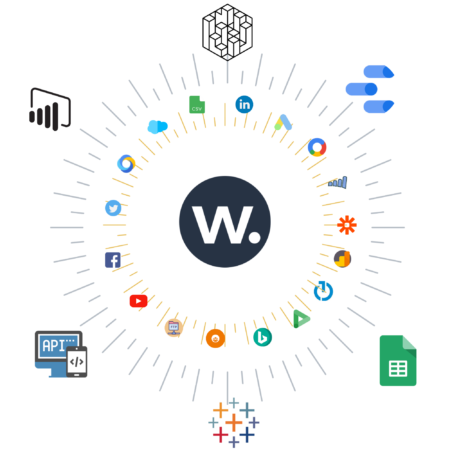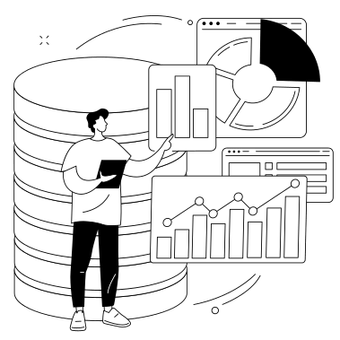Marketing Data Integration
Directly connect your marketing data, in minutes, and in an easy to use format.

Integrations for every marketing data source
Achieve more with SQL
Start integrating your marketing data
Once all your data is in a single location, things become easy. Enable machine learning or connect the world's most powerful visualisation tools: the opportunities are endlessly exciting. Use Windsor.ai to integrate your data and your favourite analytics tool to provide a big boost to your business.
See Windsor.ai in action
Why is marketing data integration so important?
While organizations invest in advanced analytics tools and the talent to operate these tools, the one component that makes or breaks the effectiveness of any organization’s analytical efforts is data integration. Data integration (DI) is a set of techniques to pull in data from different sources, merge them into one holistic view, and preserve that integration in the future.
There are a number of approaches to doing this effectively, but the most popular approaches include:
- Extract, transform, and load (ETL): data is extracted from different sources, transformed into a unified, usable format for analysis, and loaded into a database, such as a data warehouse;
- Data federation: where vast amounts of data make unification via ETL costly and inefficient, databases can be federated, allowing them to run independently but still have their data accessed holistically through federation software;
- Database replication: to ensure that data is preserved and protected, the central database (master) can be designed to push out updates to copies (slaves) when its own contents are copied;
- Data synchronization: to harmonize data between a variety of instances, such as files accessed remotely via cloud services; and
- Changed data capture: to provide meaningful metrics on how the data in the database has transformed, such as timestamps on changes and identifying the entity behind the change (for example, a particular, authorized user)
All these techniques require support for a wide range of interfaces, to allow the resulting DI solution access to databases, applications, and files to extract or load data. Solutions based on these techniques may be crafted in-house by the DI provider, based on a third-party’s tool, or a mixture of both.
Without the ability to integrate data across various customer touchpoints (for example, sales information, number of phone call inquiries made about the product), analytics yields little value, while wasting countless time and effort. This makes attribution modeling extremely difficult; if you can’t look at your data and easily understand how your consumers interact with your business and your marketing efforts, then it’s a huge hassle to determine when and how your customers became your customers.
Avoid the confusion, and gain a sense of how your customers really connect with you.
If your business is sitting on a lot of data, chances are it’s in dire need of clean-up and organization. In fact, the majority of time data analysts and data scientists spend in their workday cleaning and organizing data.
Marketing and the Significance of Data Integration
With myriad systems of customers, channels and campaigns, it can be difficult to keep all of your marketing data connected. With new data sources being added all the time, it’s essential for marketers to have the tools to continuously support their data integration needs. Data integration allows businesses to bring together all of their various data sources and provides them with actionable insights.
To thrive in today’s data-rich environment, it is worth considering outsourcing data integration. Getting outside expertise is particularly helpful if your organization moves quickly and has an opportunity to avoid the common pitfalls.
Below are practical applications of data integration in marketing:
1. Campaign Optimization
Integrated data provides valuable insights into the performance of marketing campaigns across various channels. Marketers can pinpoint the most effective strategies and allocate resources accordingly for optimal results.
2. Customer Segmentation
Through the amalgamation of data from diverse touchpoints, marketers gain the ability to effectively segment their audience. This facilitates the creation of personalized marketing campaigns tailored to specific customer groups, ultimately leading to increased engagement and conversion rates.
3. Cross-Channel Marketing
Data integration enables businesses to seamlessly execute cross-channel marketing campaigns. This involves delivering consistent messaging and offers across email, social media, websites, and other platforms, ensuring a cohesive and unified customer experience.
Advantages of Implementing Data Integration in Marketing
The implementation of data integration in marketing provides numerous benefits:
Enhanced Decision-Making
Access to comprehensive and real-time data facilitates data-driven decision-making. Marketers can swiftly adjust strategies based on performance metrics and customer behavior.
Operational Cost Effectiveness
Efficient allocation of resources, guided by data insights, results in cost savings. Marketers can eliminate ineffective strategies and concentrate on those yielding optimal results.
Competitive Edge
Businesses utilizing data integration gain a competitive edge. They can respond promptly to market changes and tailor their marketing efforts accordingly.
Enhanced Customer
Experience Data integration enables personalized marketing, enriching the customer experience. Customers receive pertinent content and offers, fostering increased brand loyalty.
Optimal Selection of Data Integration Tools for Marketing Needs
Data integration tools are software solutions designed to transfer data from a source application to a destination application. By employing these tools, you can automate the data integration process, eliminating the need for manual tasks such as copying and pasting records or exporting data in CSV files.
These tools not only save time but also enhance process efficiency. There are various types of data integration tools available, categorized based on automation methods, setup, user interfaces, and more. Examples include code and no-code tools, open-source tools, and cloud-based tools.
Given the multitude of options, choosing the most suitable marketing data integration solution can be challenging. Without a clear idea of your requirements, you might end up with an unsuitable choice. Below are some criteria to help you determine the ideal data integration tool for your business:
- Supported Data Sources: Verify that the chosen tool supports the specific data sources you need, such as particular email marketing tools or social media channels.
- Scalability: Opt for a tool that can scale according to your data requirements, whether up or down.
- Security: Ensure the security and compliance of your data by confirming that the selected marketing data integration tool prioritizes security.
- User-Friendly: Choose a tool that is easy to use and set up for seamless integration into your marketing processes.
- Pricing: Consider the pricing model of the data integration tool to ensure it aligns with your budgetary constraints.
With Windsor.ai’s data integration tool, you can onboard data from any marketing, e-commerce or CRM source, build segments and act on them in real time, with windsor.ai’s technology that consist of an attribution model which follows the customer journey from first to last touch point, and can help improve your efforts and optimize your marketing spend.

Try Windsor.ai today
Access all your data from your favorite sources in one place.
Get started for free with a 30 - day trial.




























































































































